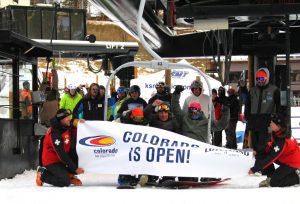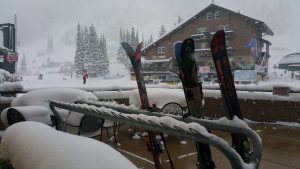Denver, CO and Salt Lake City, UT – Buoyed by deep early season storms in the West and a dearth of snowfall in the Northeast last winter, both Colorado and Utah enjoyed historically high skier visits in 2015-16 despite a nationwide economic slowdown that lasted throughout much of the season. In fact, visitation records were set in both states last winter.
Nationally, skier days were up from 53.6 million to 53.9 million in 2015-16, a modest 0.5 percent increase from the previous season despite weather challenges in the East and Midwest. According to The National Ski Areas Association’s (NSAA) annual Kottke Survey, the Rocky Mountain Region tallied a record-setting season with an overall eight-percent increase in skier visits last season over 2014-15. Utah alone was up 13 percent over the previous season.
Across the West, the strong season was verified by ski resort accommodation occupancy and revenue that both set all time records in six western states. As of April 30, actual occupancy was up 4.4 percent and revenues were up 5.2 percent compared to the previous season at a sampling of 27,500 rooms in 19 ski resort communities across Colorado, Utah, California, Nevada, Oregon and Wyoming, according to Denver-based DestiMetrics.
“There was a considerable amount of dynamic tension between economic forces and weather conditions that really shaped the ebbs and flows of this season,” reported Ralf Garrison, director of DestiMetrics. “Good early season snow in many of the western mountain resorts and dramatically better snow conditions at Far West resorts, helped offset the undeniable slowdown in economic growth and collateral impacts of the strong U.S. dollar and low oil prices. While final aggregated results were positive, there were significant fluctuations and more inconsistencies between resorts than we’ve seen in the past several years when consistent, double-digit growth was the norm,” he explained.
With skier visits estimated at over 12 million annually, Colorado is the most visited ski state in the nation. Since Vail Resorts, the owner and operator of Colorado’s four most visited resorts — Vail Mountain, Breckenridge, Keystone and Beaver Creek — pulled out of the trade group Colorado Ski Country USA (CSCUSA) in 2008, exact totals are impossible to ascertain as Vail Resorts no longer publicly breaks down skier visits at its resorts by state. However, CSCUSA reports that skier visits at its 21 member resorts totaled 7.4 million in 2015-16, up by nearly five percent compared to the previous season and a new record for visitation. Separately, Vail Resorts also reported strong visitation at its Colorado resorts last winter.
Additionally, the 2015-16 season skier visit total for CSCUSA members bested the five-year average by more than 10 percent, making it the third consecutive year skier visits in Colorado have outpaced the five-year average.
“Seeing our members’ visitation overtake their previous record demonstrates the passion and dedication our guests have for Colorado’s signature sports” stated Melanie Mills, president & CEO of Colorado Ski Country USA. “It also makes clear the nonstop commitment our member resorts have to providing the best ski product in the world by setting the industry standard for guest service, skier safety and quality snow conditions.
“Colorado’s reputation as the number one ski destination is evidenced by our ownership of 24 percent of the 2015-16 national skier market,” added Mills. “It’s a testament to our members’ dedication to provide a top-notch guest experience from friendly employees who offer a welcoming spirit to a consistent snow surface with plenty of powder days.”

As is usually the case, skier visits are driven primarily by snow conditions. Fall snowmaking paired with ideally timed snow storms and blanketed resorts across Colorado with copious amounts of early season snow last winter. Loveland Ski Area and Arapahoe Basin both opened on October 29, 2015 and launched Colorado’s ski season.
“The season started with excellent conditions and resorts handedly delivered on skier demand fueled by buzz of a Godzilla El Niño,” said Mills. “Our savvy in-state skiers took advantage of the best early season conditions Colorado had in recent memory.”
More snow came in November and December which allowed resorts to open ample terrain during the holidays. A series of well-timed storms led to 100-inch milestones being met before the end of 2015 to the delight of holiday skiers and riders.
Despite spells of warm, dry weather in January and February, typical of an El Niño weather pattern, CSCUSA resorts received more than enough early season snow to provide enjoyable mid-winter conditions complemented by sunny days and mild temperatures. Steady snowfall eventually returned in April to cap off the season.
“In many ways it was a story of two springs with the latter half bringing a deluge of snow resulting in resort season extensions, re-openings and bonus weekends,” commented Mills.
There’s a light-hearted interstate ski rivalry that crosses the border between Colorado and neighboring Utah. Although Colorado sees nearly triple the number of skier visits, Utahns tout their state’s “Greatest Snow On Earth” and diverse terrain, along with ease of access through Salt Lake International Airport, which is an hour’s drive or less from no fewer than 10 of the state’s 14 ski resorts. The Utah ski and snowboard industry closed the 2015-16 winter season with a total of 4,457,575 million skier days, up nearly five percent from the previous record of 4,249,190 during the 2007-08 season. This year’s number represents a 10.4 percent increase vs. Utah’s five-year average of 4,037,349.

On Memorial Day, Snowbird Ski and Summer Resort finally stopped spinning lifts for the winter, finishing off with an impressive 181-day season. While season-ending snow totals were not record-setting, conveniently timed, early season storms attributed to the success of the season, as they did in Colorado. Other important contributions toward this accomplishment can be credited to Utah Office of Tourism’s overwhelming financial support of the state’s ski industry, and the significant resort capital improvements statewide totaling over $100 million, including $50 million by Vail Resorts at Park City Mountain Resort alone. As a result, nearly half of Utah’s resorts reported individual record-breaking skier visits.
“This was a big year for Utah’s winter sports industry and we could not have asked for a better result,” said Ski Utah President Nathan Rafferty. “Credit can evenly be distributed to the collaboration of Utah’s 14 resorts, the tremendous support from the Utah Office of Tourism and the private investment in resort infrastructure.”

